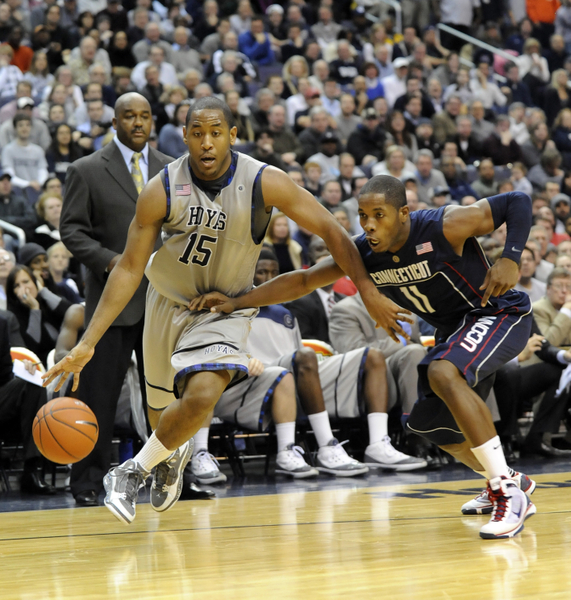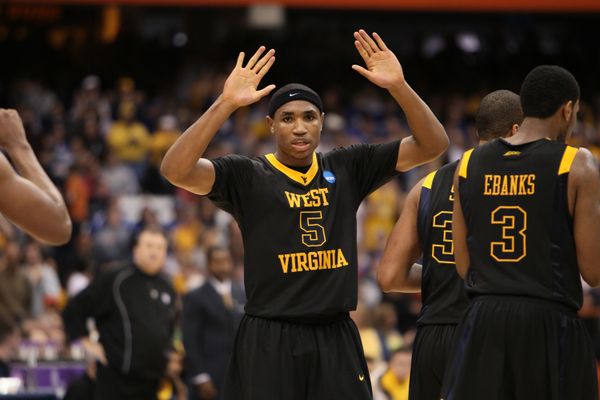RTC 2010-11 Impact Players – Mid-Atlantic Region
Posted by rtmsf on October 7th, 2010It’s October. The leaves are starting to turn colors. Halloween candy is already in the stores. There have been a few nights where you may have even turned on the heat. Midnight Madness is less than two weeks away and RTC is ready to jump into the 2010-11 Season Preview materials headfirst, like a ten-foot stack of those leaves that you just raked into a giant pile. For the second October in a row, we’re going to bring you our RTC Impact Players series. The braintrust has gone back and forth on this throughout September and we’ve finally settled on a group of sixty players throughout ten geographic regions of the country (five starters plus a sixth man) to represent the who and where of players you should be watching this season. Seriously, if you haven’t seen every one of these players ball at least once by the end of February, then you need to figure out a way to get a better television package. As always in a subjective analysis such as this, some of our decisions were difficult; many others were quite easy. What we can say without reservation is that there is great talent in every corner of this nation of ours, and we’ll do our best to excavate it over the next five weeks in this series that will publish on Mondays and Thursdays. Each time, we’ll also provide a list of some of the near-misses as well as the players we considered in each region, but as always, we welcome you guys, our faithful and very knowledgeable readers, to critique us in the comments.
You can find all previous RTC 2010-11 Impact Players posts here.
Mid-Atlantic Region (NJ, PA, WV, DE, MD, DC)
- Austin Freeman – Sr, G – Georgetown. It’s hard to find a glaring weakness in Austin Freeman’s game. In a conference lacking the star power it normally touts, Freeman is the one player without a handful of flaws, concerns and question marks heading into 2010-11, a big reason why we believe he should be the preseason favorite to take home Big East Player of the Year honors next March. It’s obvious Freeman can shoot. Just ask Jim Calhoun about when the DeMatha HS product lit up his Huskies for 33 points on 5-9 from downtown in a comeback victory. Or just ask every coach in the Big East conference because it’s extremely likely Freeman made them pay on at least one occasion last season. The 6’3 junior shot a staggering 44% from three and 53% overall as a shooting guard who attempted 383 field goals last season. He also ranked in the top 100 in both effective FG% and offensive rating. Sure, plenty of the open looks were a result of opposing defenses keying on departed Hoya big man Greg Monroe, but GU still has enough playmakers on this year’s roster — Chris Wright, Jason Clark and Hollis Thompson to name a few — to free up shots for Freeman. While he may not be the most explosive athlete on the planet, Freeman makes up for that weakness with tremendous strength, especially fighting around screens and utilizing his quick release from deep. He also stays on John Thompson’s good side by limiting turnovers to around two per game. Off the court, Freeman has now had an entire summer to adjust to the news he received in February that he was diabetic. Reaching the charity stripe at a higher frequency should also be a point of emphasis for Freeman to improve on this season. In the Big East championship game loss to West Virginia and the embarrassing defeat at the hands of Ohio in the first round of the NCAA Tournament, Freeman did not attempt a single free throw. In fact, he didn’t even shoot 100 FTs all season. Maintaining his efficient shooting totals and increasing the chances for free points is a combination that should combined to produce the most complete player in the Big East.
- Talor Battle – Sr, G – Penn State. Talor Battle dabbled with the thought of entering the NBA Draft last spring, and who could blame the electrifying guard from central Pennsylvania? After a tremendous sophomore season where his team went 27-11 and won the NIT title, he lost talented teammates Stanley Pringle and Jamelle Cornley to graduation, resulting in a severe free fall back to the bottom of the Big Ten (11-20, 3-15). Still, Battle persevered through the mounting number of losses by playing heavy minutes (37.0 MPG) and continuing his march toward the very top of the Penn State basketball record books. Despite his diminutive 5’11, 160-lb frame, the two-time all-Big Ten guard (1st team in 2009; 2d team in 2010) who can do a little bit of everything is on pace to become Penn State’s all-time leading scorer and the best rebounding guard in the history of the program. His season averages of 18.3 PPG, 5.3 RPG and 4.2 APG in 2009-10 were matched by only one other player in all of D1 basketball (NPOY Evan Turner) and he was also the only player among the 73 BCS programs who led his team in total points, rebounds, assists and steals. Individual statistics are nice, but Battle would rather see more wins this season and there are some encouraging signs that his decision to return may be a good one. Seven of PSU’s fifteen Big Ten losses last season were by six points or less, and the Nittany Lions were 3-3 in their last six regular season games with close losses to league leaders Purdue and Michigan State. With all five starters returning for Ed DeChellis’ team, the hope for Battle is that some of those close games will break the other way with his senior leadership and shot-making abilities making the difference at the end. It’s unlikely that PSU has an NCAA Tournament appearance in its immediate future (its last was a decade ago), especially in the brutal Big Ten, but an overall winning record and another trip to the NIT is a reasonable goal for Battle and friends to aspire toward.
- Corey Fisher – Sr, G – Villanova. After playing in the shadow of Scottie Reynolds for the past three seasons, Corey Fisher is primed to break out and make a name for himself on the national stage. Nowhere was this more evident than his already legendary 105-point performance this summer in a Bronx summer league game. Although his competition that day was significantly less talented than what he will see in the Big East this season, Fisher’s barrage offers us a glimpse of what he is capable of doing when he is unleashed. While we believe that Fisher can replace the offensive output that the Wildcats will lose with Reynolds’ departure, we aren’t so sure that he can replace the leadership that Reynolds provided. Jay Wright will need Fisher to step up in a major way for what should be a top 25 team. Although Fisher was a fairly consistent scorer last season (only failing to score double digits in one loss—the season-finale to St. Mary’s), the Wildcats will look to him to shoulder an increased burden as opposing coaches will no longer have to scheme to contain Reynolds and can focus on limiting Fisher and Corey Stokes on the perimeter. Fisher already is an excellent facilitator, averaging a team-leading 3.9 APG last season while sporting a 1.9-to-1 assist-to-turnover ratio, and he should have a solid supporting cast with two other starters returning for their season seasons as well. Fisher is near the same level of talent as many of the excellent Villanova guards of recent years (Reynolds, Allan Ray, Randy Foye), but has not been asked to demonstrate that ability yet because so much of the Wildcats attack has relied on the brilliance of Reynolds. The big question everyone has is whether Fisher will be able to create and hit the big shots for the Wildcats in crunch time, as his former backcourt mate has done the past few seasons. If Fisher is able to do that, he has the complementary pieces in place to lead Jay Wright deep into March yet again.
- Jeremy Hazell – Sr, G/F – Seton Hall. Last year was a wild and wooly one for Jeremy Hazell and his Seton Hall Pirates. Despite going 9-9 in Big East play and getting invited to a postseason tournament (NIT) for the first time in four years, there was an underlying sense all season that the program under Bobby Gonzalez was spiraling out of control. This sentiment manifested itself in March with a succession of ugly incidents involving Hazell’s teammates Robert Mitchell (dismissed), Keon Lawrence (returning), and Herb Pope (returning, but with possible health issues), ultimately resulting in the firing of Gonzalez in March. All the while, Hazell, a two-time RTC Impact Player, kept on keeping on. The 6’5 two-time all-Big East wing with lights-out distance on his jumper threw in 20.4 PPG while grabbing 3.5 RPG and dropping 1.5 APG last year. Perhaps no game personified Hazell’s characterization as a no-conscience gunner than his 41-point outburst against West Virginia immediately before the new year. In that overtime loss to the Mountaineers, Hazell shot the ball a ridiculous 33 times, connecting on 14 of them. Nineteen of those attempts were from beyond the arc, but even though he only connected on four, it was the two he hit from 25-feet during a late flurry that sent the game to overtime giving his team another chance to win. Hazell reminds you of the old mantra: you make zero percent of the shots you don’t take. That Hazell had the confidence to take and make those clutch threes after bricking so many all game long shows just how much moxie the kid has — but he’s not only about firing up the ball at the basket. Because of the additional talent on the Pirate roster last season, Hazell looked to distribute the ball more efficiently rather than always looking for his own shot, and he was successful. In 2008-09, Hazell assisted on 29 plays while turning the ball over 69 times (a dreadful A:TO of 0.3); last season his assist totals went up to 47 (he’ll never be Jason Kidd, here) while his turnovers dropped substantially to only 39 (for a much better A:TO of 1.2). That’s what you call maturity — the ability to play under control and know better when and how to pick your spots. New head coach Kevin Willard believes that his team with five seniors led by Hazell has a shot at the NCAA Tournament in 2011, and he may be right. Much of whether that comes to fruitiion, though, will depend on the continued maturation of the gifted scorer out of Harlem who will more than likely leave Seton Hall next spring not only with his degree but also with the distinction of becoming the top scorer in the history of SHU basketball (he needs 705 points to catch Terry Dehere).
- Kevin Jones – Jr, F – West Virginia. Welcome to center stage, Mr. Jones. During his first two seasons in Morgantown, Kevin Jones has had the privilege of playing alongside the likes of Alex Ruoff, Da’Sean Butler and Devin Ebanks, and as he’s gone about his business he’s watched those players — and even others with fewer touches and minutes, like Joe Mazzulla and Deniz Kilicli — enjoy more buzz and popularity among even the most astute of hoopheads. There’s nothing wrong with demurring to players on the level of Ruoff, Butler, and Ebanks, and it’s not as if Jones has played in total anonymity. It’s our view, though, that Jones has never quite received the props he’s deserved. Even on his own team last season, he was considered the third-best scoring option behind Butler and Ebanks despite being second on the squad with 13.5 PPG, a number he more than doubled from his freshman season to make up for the scoring burden left behind from the departure of Ruoff. Because of the increased point production, when you hear of Kevin Jones you almost never hear about his rebounding prowess, and here’s a guy pulling down 7.2 RPG last year, good enough for second on the team and 11th in the conference (and the Big East isn’t exactly bereft of glass cleaners). Wouldn’t you expect to hear more about a fellow who shot a tidy 49.5% (tops for his team) and 52.1% (second on the team, 0.4% behind Kilicli, who shot 342 fewer shots) from the floor in his freshman and sophomore seasons, respectively? And that 52.1% from last year includes a 40.4% mark from behind the three-point arc. Behold, then, the reward for patience, for this is Jones’ team now. He will most assuredly be the first option for the 2010-11 edition of the Mountaineers, which means almost every one of those numbers (we’ll allow for a small slippage in FG%) from his sophomore campaign will increase — even his 33.0 MPG. You’ll sense little surprise from here if Jones manages to post averages along the lines of 18/10. Most folks might be quick to dismiss the ‘Eers after losing Butler and Ebanks, but West Virginia still has the components and coaching in place to make a deep NCAA Tournament run. Their fate will be determined by how well Kevin Jones handles the transition from relatively unsung third option on his own team to Big East POY candidate. We think he’ll manage just fine.
- Lavoy Allen (6th) – Sr, F – Temple. For Temple to live up to its 2010-11 hopes, they’ll need Allen to recreate and improve upon his performance from last year, when he became the first Owl since Ollie Johnson in 1970-71 to average a double-double. While the Owls return point guard Juan Fernandez, A-10 sixth man of the year Ramone Moore and junior center Michael Eric to pair with Allen in the frontcourt, it is Allen who is the special talent on this team, a guy who thought about the NBA Draft before returning to Philly for his senior season. Allen is truly a special rebounder, capable of rebounding as well on the offensive end (such as when he grabbed nine offensive boards to pair with his 12 defensive rebounds at La Salle last February) as he is on the defensive end. Aside from his double-double average, Allen also led the Owls in blocks, chipped in nearly 2.5 assists nightly, hit 54% from the field and was the Owls’ most efficient offensive player. But, for the second consecutive year, Allen’s free-throw percentage dropped, this time down to 63%, quite a drop from the 74% he hit as a freshman. Further, Allen has never been the most aggressive player, drawing only three fouls per 40 minutes last season, a meager number for such a skilled player. Allen has excellent footwork, great instincts, and a bevy of offensive moves (jump hooks, turn-around jumpers, drop-steps, and an improving face-up game) and is on the short list of the best passing big men in college basketball, but all too often, those skills can disappear for long stretches of time. For instance, in the Owls’ season-ending loss to Cornell in the first round of the NCAA Tournament last season, Allen only attempted seven field goals (and made five of those), and grabbed just five rebounds. In order for Temple to play up to their potential, Allen needs to become a bigger part of the Owl offense on a regular basis, and if he can return to the capable free-throw shooter he was as a freshman, the Owls can be a strong contender for the conference crown.
Near-Misses
- Ashton Gibbs – Jr, G – Pittsburgh. In a region loaded with great guard play, Gibbs was difficult to leave off our Impact Players team. He does everything well, especially taking care of the ball (only forty turnovers all season) and knocking down open threes (at a near-40% clip).
- Damian Saunders – Sr, F – Duquesne. Saunders is the best player nobody has ever heard of — the 6’7 senior averaged 15/11 and nearly three assists, steals and blocks per game last season en route to first-team all-A10 and conference DPOY selections.
Others Considered (* denotes injury or suspension)
- Vlad Moldoveanu – Sr, F – American
- Mike Muscala – Soph, C – Bucknell
- Jawan Carter – Sr, G – Delaware
- Chris Wright – Sr, G – Georgetown
- Jared Mintz – Sr, F – Lafayette
- CJ McCollum – Soph, G – Lehigh
- Jordan Williams – Soph, F – Maryland
- Kevin Thompson – Jr, F – Morgan State
- Zack Rosen – Jr, G – Pennsylvania
- Gilbert Brown – Sr, F – Pittsburgh
- Bran Wanamaker – Sr, G – Pittsburgh
- Dan Mavraides – Sr, G – Princeton
- Karon Abraham – Soph, G – Robert Morris
- Dane Miller – Soph, F – Rutgers
- Herb Pope – Jr, F – Seton Hall
- Jeff Robinson – Sr, F – Seton Hall
- Juan Fernandez – Jr, G – Temple
- Corey Stokes – Sr, G – Villanova
- Maalik Wayns – Soph, G – Villanova
- Antonio Pena – Sr, F – Villanova















































“A region loaded with great guard play.” It really is amazing when you look at guys like Battle, Hazell, Fisher, Freeman, Gibbs, Wright, Fernandez, Wanamaker, Stokes and Wayns. Even a guy like Zack Rosen is a really good player but doesn’t come close to making this team. Loaded region.